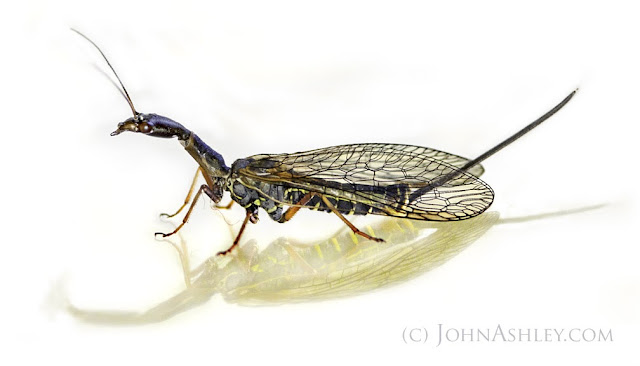 |
| Female Snakefly standing over her reflection on glass |
Like the time last summer when John called to tell me about a strange bug he'd captured in a jar, holding it for further inspection after finding it perched on a kitchen window pane. I promised to stop on my way home from town to look at his bug.
Boy, was it ever strange.
 |
| Female snakefly |
John was thrilled to find his answer. Snakefly (Agulla spp.). Digging for more information was like digging through history.
Modern snakeflies are the small surviving relict of a much larger, ancient order. They originated early in the Mesozoic Era and used to be very diverse in habitat use and number of species.
But their once-global distribution took a sudden nosedive at the end of the relatively warm Cretaceous Period, 65 million years ago, when a large asteroid impact is thought to have caused a sudden climate change, quickly cooling the Earth. Almost all of the snakefly species went extinct.
The few snakefly lineages to survive were those that were already living in cooler environments before the climate changed. Today, snakeflies only live in temperate habitats that are subject to freezing temperatures - in fact, these species require the cold to complete their pupal development.
Juvenile snakeflies do not develop or survive if the temperature is too warm. So for a group of animals that barely survived one sudden climate change towards cooling, our current climate lurch towards warming may be the global event that knocks the genus out completely.
Of course, they'll be joined by many, many interesting animals that will be lost to curious kids. Hopefully, we'll get the chance to learn a little more about these critters before they're gone. Those of us who cling to our child-like wonder are thrilled to learn about most any living animal we discover - especially strange, ancient bugs like snakeflies.
John and I learned that our modern snakeflies live exclusively in trees, which makes it an even bigger mystery to find one in the kitchen. And that wicked-long tail? That clue told us that this snakefly was a female, and her tail is actually an ovipositer that's extra long so she can insert her eggs safely under tree bark. Females cannot sting with their ovipositer, and snakeflies are harmless to inquisitive kids. (Males do not have an ovipositer or any visible "tail.")
Female snakeflies also have the curious habit of "wagging" their ovipositor back and forth while eating, like a puppy, "...as though expressing satisfaction with the food," (as one person described it in 1936). After feeding, adults take time to clean themselves. Adults and larvae are both predatory, eating the eggs and larvae of small insects and spiders. Aphids are a favorite food, and there have been several unsuccessful attempts to use snakeflies as biological controls on pest insects.
Larval snakeflies are also strange, but they look nothing like the adults. They look sort of like a cross between a flattened centipede and a large ant. They're surprisingly fast-moving in both forward and reverse gears. The larval stage lasts 1-6 years, depending on the species, and they'll moult 10-15 times during this period. Pupation from larvae to adult usually lasts just a few days in spring, but it requires those cold temperatures to succeed.
Just two days after finding his first adult snakefly last summer, John successfully captured a second one - on the kitchen window once again. Hoping for more discoveries like these insects, I'm going to surprise John with a bug terrarium for his birthday.
My curious neighbor turned 74 years young today.
.

